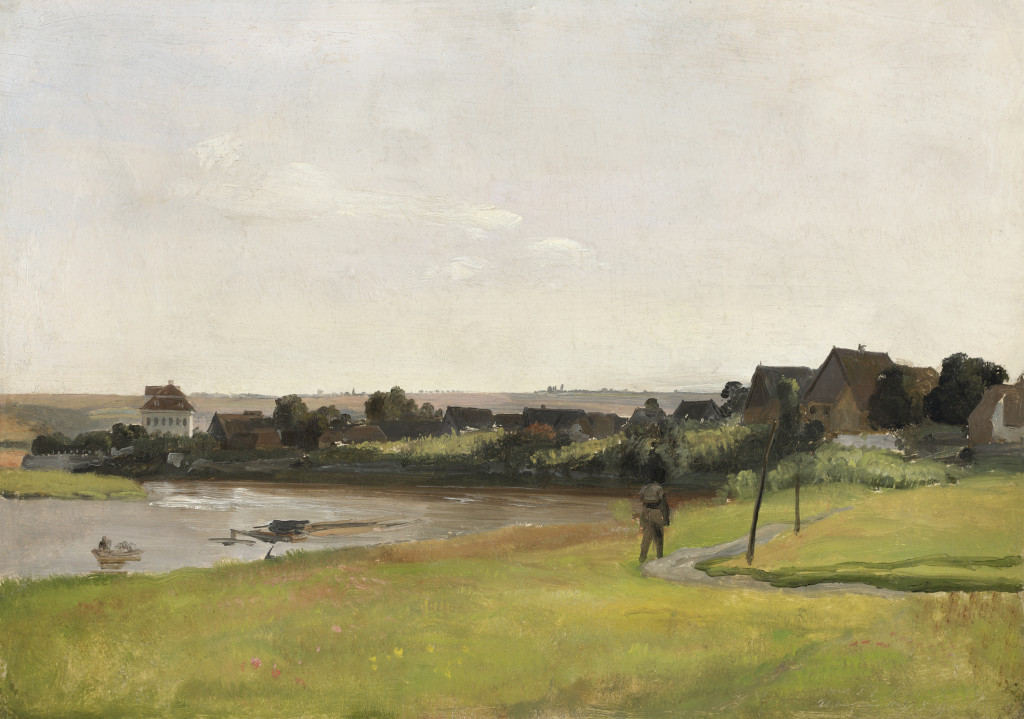Christian Friedrich Gille (Ballenstedt 1805 - 1899 Dresden)
River Elbe at Übigau near Dresden, 1833
Oil on paper laid down on cardboard, 26.7 x 37.7 cm
Signed, dated and inscribed lower right am 27 May 33 CG/ Ubigau nach 5 Uhr (scratched into the wet paint)
On the verso with a printed label Graphisches Kabinett, Günther Franke, Briennerstr. 51 and the typed inscription Christian Friedrich Gille, Dorf am Teich (s. Abb. b. Gerstenberg-Oel)
Provenance:
Johann Friedrich Lahmann, Dresden
Günther Franke[1], Munich
Private collection, Germany
Literature:
Kurt Gerstenberg, ‘Christian Friedrich Gille’, in Dresdner Kunstbuch, Dresden 1927, p. 14, pl. 5 (not ‘6’ as stated in the article)
Gerd Spitzer (ed.), Christian Friedrich Gille 1805-1899, exhib. cat., Dresden, Staatliche Kunstsammlungen and Bremen, Kunsthalle, 1994-5, Leipzig 1994, p. 22, ill. 12 (as ‘present location unknown’)
Of all the pupils of Johan Christian Dahl in Dresden, Christian Friedrich Gille was probably the keenest exponent of painting sur le motif, closely following the advice of the landscape painter Carl Gustav Carus as expressed in the eighth letter of his treatise, Nine Letters on Landscape Painting: The artist must therefore learn to speak the language of nature; and the place of such instruction can only be the natural landscape itself […].[2] Most of Gille’s motifs are small, unspectacular scenes executed from nature, for the most part in Dresden and its surroundings. Gille did not play a prominent role in the artistic life of Dresden. He earned his living as a printmaker and had little contact with other artists. He rarely even travelled in Germany and never visited Italy. The plein-air oil sketches on which his modern reputation is based were little appreciated by his contemporaries. Unlike his teacher Dahl he left very few finished paintings. Due to his small output of finished works he died in relative obscurity.
The present delightful sketch documents Gille’s skill in combining the bold, expansive brushstrokes of the foreground with a concentration on minute detail, particularly in the treatment of the distant skyline. It is important to note that the artist not only felt the necessity to note the exact date of execution but also the time of the day he finished this sketch – probably in reference to weather and light conditions on that specific day.
A remarkable example of the artist’s work, the present sketch was highly regarded by its former owner, the collector Johann Friedrich Lahmann (1858-1937)[3], who rediscovered Gille's oeuvre after the artist’s death in the early 19th century and went on to form what was probably the largest collection of his sketches and paintings. Kurt Gerstenberg was the first art historian to re-evalute Gille’s plein-air landscapes. His essay of 1927 is based on the study of works from the Lahmann collection. It was not until Lahmann’s generous donation of the greater part of his estate to the museums in Dresden and Bremen in 1937 that a wider audience became acquainted with Gille's œuvre.
[1] Günther Franke (1900-1976) started out as an art dealer in the 1920s, specialising in German Expressionism, the work of Max Beckmann and French classical modern art. The advent of National Socialism put an end to open dealing in German Expressionism and he turned to early 19th-century paintings, particularly to plein-air painting which he saw as the undisputed forerunner of the modern movement.
[2] Carl Gustav Carus, Neun Briefe über Landschaftsmalerei: geschrieben in den Jahren 1815-1824, Leipzig 1831, p. 157: Die Sprache der Natur soll also der Künstler reden lernen, und der Hörsaal, wo ein solcher Unterricht von ihm empfangen werden kann, ist nur die freue Natur selbst [...].
[3] Kunstverein in Bremen (ed.), Johann Friedrich Lahmann, exhib. cat. Kunsthalle Bremen, Bremen 1995.

